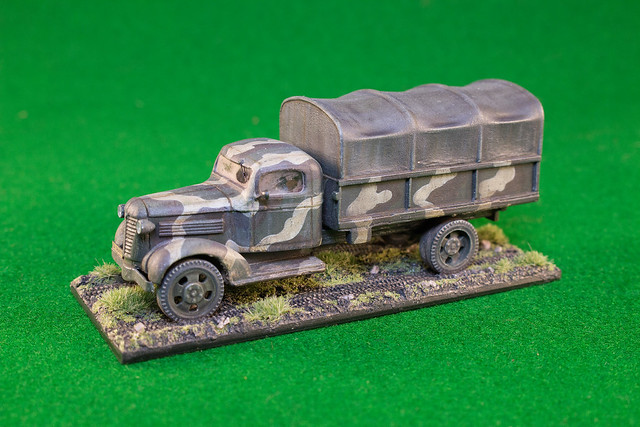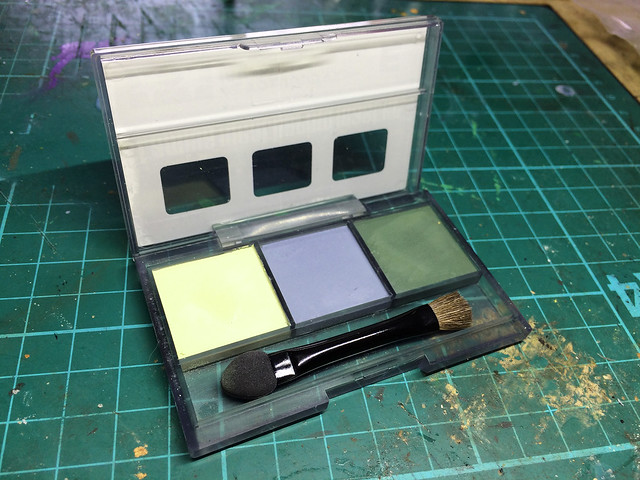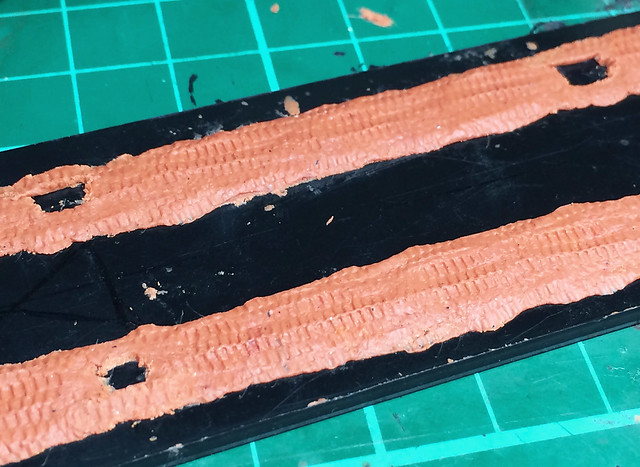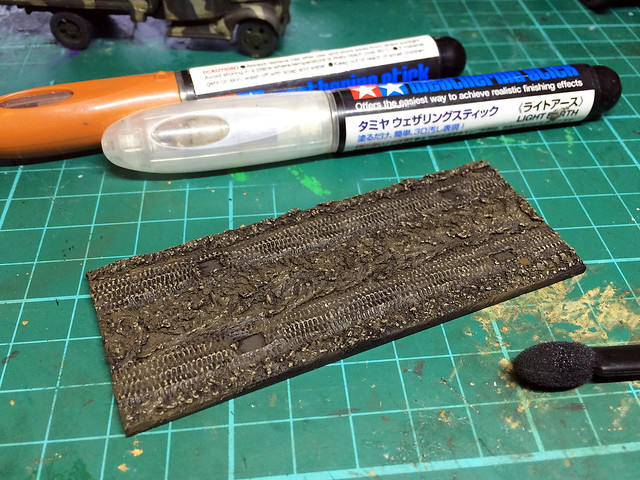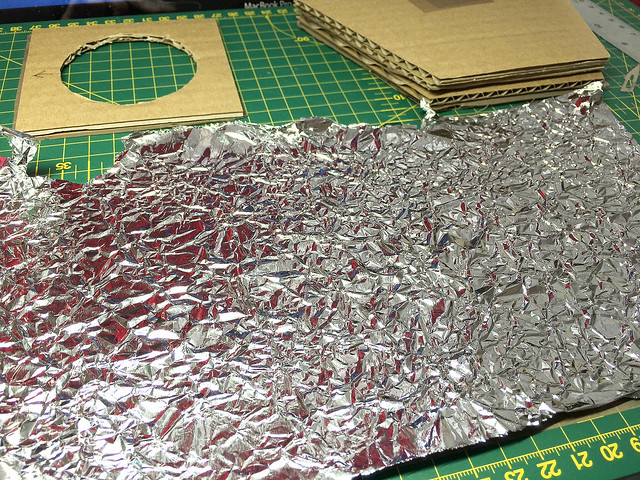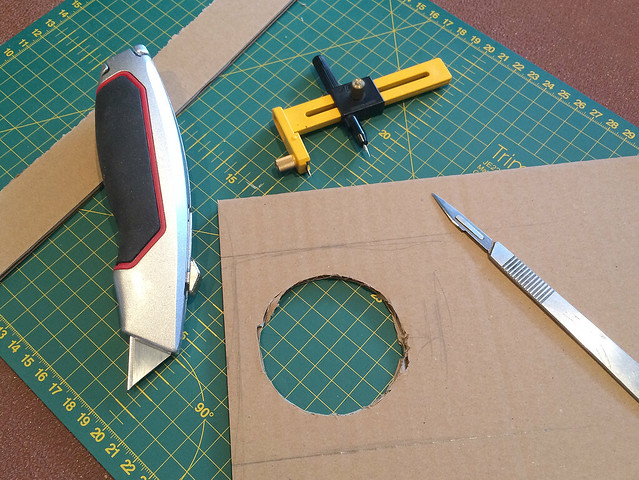Phew! Well, this has been a bit of a marathon (even for me)! I can't believe that such a simple model as Minairon's 1937 Chevrolet has taken me so long to complete - though, to be fair, I've had a lot of 'real life' distractions this year.
Anyway, my Finnish 37 Chevy truck is done...
I'm quite pleased with some of the weathering tricks that I've learned with this one - the use of eyeshadows was a particularly interesting addition to my skill set!
Onwards and upwards!
Postscript: I nearly forgot to mention. This is the first use of my 'new' photography lamps - I'm rather chuffed with the end product!
Diary of a novice scale model maker and his adventures in the wacky world of Braille Scale.
Wednesday, 25 May 2016
Friday, 20 May 2016
Next: Tiger's Cartoon 'CUTE Series' P-40 Warhawk
Felt I needed a little change of pace and I happened to see a few examples of Tiger's warplane caricature models on Facebook's The Plastic Scale Model Making Group (which I recommend as it's a very friendly group).
I found the Tiger models easily enough on eBay and at £10 (free postage) from China and quickly ordered one, about 10 days later this arrived...
These models really caught my imagination and they offer a more relaxed approach to scale modelling (as with fantasy modelling, no matter what you do nobody can tell you that you're doing it 'wrong'). Just what I needed after doing 'historic' modelling where you are constantly second-guessing yourself and how 'authentic' your modelling is.
Obviously, there isn't really a scale to these I don't think, but here's a shot of the sprues so you can get an idea of the size...
I did have a bit of a puzzle as to which of this series to buy, they all look 'cute'. In the end, I went for an old favourite - the P-40 Warhawk - but if this works out I would be very tempted to get one or two more in the series...
The model comes with a rather nice colour pattern, but you could do any scheme you wanted really (see sample below). I also think, your could look to your decal scraps box as P-40 was used by a large number of nations...
Funnily enough, the kit comes with two types of decal - conventional water-slide decals and some self-adhesive 'stickers'. This is great for younger modellers as these kits would make for fun projects for the kids.
I haven't decided whether to stick with the iconic 'Flying Tigers' scheme or do something else - I'll have to have a think (and check what spare decals I have if I want to do something different). It's quite exciting to think of all the options.
Here's an example (from the Tiger publicity) of a possible scheme, and very nice it looks too...
Hope mine turns out as nice!
I found the Tiger models easily enough on eBay and at £10 (free postage) from China and quickly ordered one, about 10 days later this arrived...
These models really caught my imagination and they offer a more relaxed approach to scale modelling (as with fantasy modelling, no matter what you do nobody can tell you that you're doing it 'wrong'). Just what I needed after doing 'historic' modelling where you are constantly second-guessing yourself and how 'authentic' your modelling is.
Obviously, there isn't really a scale to these I don't think, but here's a shot of the sprues so you can get an idea of the size...
 |
| The length of the fuselage is 8.7cm. |
The model comes with a rather nice colour pattern, but you could do any scheme you wanted really (see sample below). I also think, your could look to your decal scraps box as P-40 was used by a large number of nations...
Funnily enough, the kit comes with two types of decal - conventional water-slide decals and some self-adhesive 'stickers'. This is great for younger modellers as these kits would make for fun projects for the kids.
I haven't decided whether to stick with the iconic 'Flying Tigers' scheme or do something else - I'll have to have a think (and check what spare decals I have if I want to do something different). It's quite exciting to think of all the options.
Here's an example (from the Tiger publicity) of a possible scheme, and very nice it looks too...
Hope mine turns out as nice!
Thursday, 19 May 2016
Weathering products - cheap and cheerful
I have been very fond of Tamiya's Weathering Sticks...
This soft, oily crayon type medium adheres very well to the surface of your model, either as greasy layer or in clumps. As such it's great for creating mud effects. But it's not exactly subtle, for more even semi-opaque dust effects I have been using powder pigments.
But getting powders to stick to a surface means you have to add some form of binder (or fix the pigment using a spray varnish).
I recently came across another Tamiya weathering product that has some of the properties of both pigments and weathering stick, called Tamiya Weathering Master 'Drybrush Effect' (£6.98).
This medium has the consistency of powder but incorporates a very mild binder so that it sticks to the surface to which you apply it. It isn't oily - like the weathering stick medium - and can be brushed on delicately (like a dust) or applied a little thicker (like a cream).
In fact, this medium reminded me of something...
I had shown the Tamiya set to my daughter and she agreed that it did look like eyeshadow (or cosmetic powder/cream of some sort). I'm sure it's not, but the similarity in texture was hard to ignore, so I popped into Boots and picked up a box of very cheap eyeshadow (£2.99).
For my £2.99 I got a set of 6 eyeshadow colours (as opposed to just the 3 in the Tamiya weathering set). However, the very first ting I noticed were that a couple of these were vaguely 'metallic' or glittery!
Another quick chat with my daughter informed me that you can get matt eyeshadow, so that's something to be aware of if you decide to try this out for yourself. I tried out the colours that were matt(ish) on my 37 Chevrolet model, and got some reasonable results.
There is a difference between the Tamiya weathering medium and eyeshadow (unsurprisingly, otherwise that would be a huge rip-off)! The main difference being the consistency of the binding agent used - the Tamiya medium is a little more sticky than eyeshadow, eyeshadow being more powdery.
I'd say that eyeshadow, then, is halfway between pigment powders and the Tamiya weathering medium. It's actually quite nice to use, just having that slight adherence that powders only bearly have (without adding a binder or fixing agent, powders tend to wipe off as easily as they go on).
Eyeshadow can 'smear', being a tiny bit oily. But they are a little more subtle or translucent than Tamiya's weathering 'cream' (sorry - I'm struggling here to describe the various mediums precisely).
So...Is Tamiya's Weathering Master Drybrush Effect set just expensive eyeshadow? No. It's subtle but the levels of binding and translucency are different and the Tamiya product is obviously designed with modelling specifically in mind (as it should be).
But...Eyeshadow is an interesting medium in its own right and does offer some unique properties that compliment you other weathering mediums. It's all a sliding scale and depends on how 'sticky' and how translucent and how much you want the medium to spread, but eyeshadow will be a part of my weathering toolbox from now on.
...Oh...And one more advantage of eyeshadow, when you compare it to Tamiya's set. You do get a lot more bang for your bucks...
Above: Having satisfied myself that eyeshadow is worth adding to my weathering palette I splashed out on a larger set. The set shown includes 88 colours, and despite about 20% of them being a bit glittery or metallic the £8.99 they cost me still makes eyeshadow a very cost-effective weathering medium when compared to 'specialist' modelling mediums. Note the subtle gradation in colours and tones.
This soft, oily crayon type medium adheres very well to the surface of your model, either as greasy layer or in clumps. As such it's great for creating mud effects. But it's not exactly subtle, for more even semi-opaque dust effects I have been using powder pigments.
But getting powders to stick to a surface means you have to add some form of binder (or fix the pigment using a spray varnish).
 |
| Powder pigments - whether specialist makes like Vallejo or Humbrol or my cheap variation using artists chalks - require a fixing agent to adhere the medium permanently. |
This medium has the consistency of powder but incorporates a very mild binder so that it sticks to the surface to which you apply it. It isn't oily - like the weathering stick medium - and can be brushed on delicately (like a dust) or applied a little thicker (like a cream).
In fact, this medium reminded me of something...
I had shown the Tamiya set to my daughter and she agreed that it did look like eyeshadow (or cosmetic powder/cream of some sort). I'm sure it's not, but the similarity in texture was hard to ignore, so I popped into Boots and picked up a box of very cheap eyeshadow (£2.99).
For my £2.99 I got a set of 6 eyeshadow colours (as opposed to just the 3 in the Tamiya weathering set). However, the very first ting I noticed were that a couple of these were vaguely 'metallic' or glittery!
Another quick chat with my daughter informed me that you can get matt eyeshadow, so that's something to be aware of if you decide to try this out for yourself. I tried out the colours that were matt(ish) on my 37 Chevrolet model, and got some reasonable results.
I'd say that eyeshadow, then, is halfway between pigment powders and the Tamiya weathering medium. It's actually quite nice to use, just having that slight adherence that powders only bearly have (without adding a binder or fixing agent, powders tend to wipe off as easily as they go on).
Eyeshadow can 'smear', being a tiny bit oily. But they are a little more subtle or translucent than Tamiya's weathering 'cream' (sorry - I'm struggling here to describe the various mediums precisely).
So...Is Tamiya's Weathering Master Drybrush Effect set just expensive eyeshadow? No. It's subtle but the levels of binding and translucency are different and the Tamiya product is obviously designed with modelling specifically in mind (as it should be).
But...Eyeshadow is an interesting medium in its own right and does offer some unique properties that compliment you other weathering mediums. It's all a sliding scale and depends on how 'sticky' and how translucent and how much you want the medium to spread, but eyeshadow will be a part of my weathering toolbox from now on.
...Oh...And one more advantage of eyeshadow, when you compare it to Tamiya's set. You do get a lot more bang for your bucks...
Sunday, 15 May 2016
Photographing models - improved lighting Part 3
Right, last part. In this post, I put all the components together and try out a test photo to see if the quality of the light which is given out by my mini-studio lamps is improved. But, first of all, let's look at the foil covered components...
Now, I should mention - this being the first time I have tried using box cardboard as a construction material - that the first thing I learned is - go easy on the PVA!
The cardboard was more absorbent than I expected and it soaked the PVA up like a sponge. This lead to some floppy and soggy components which took a lot longer to dry out than expected. Too much PVA glue also caused the wet card to deform (I had to place some heavy books on them to flatten them out).
Despite this, I still think cardboard is the ideal medium for this project because of its light weight.
Next, I reconstructed the boxes...
Once again, I used parcel tape as the primary means to connect the components together. Once I am satisfied with the fit I will be gluing the parts permanently to one another (probably using a glue gun). At this point, the tape will help to hold things steady and in position while I glue one joint together at a time.
To make the boxes a little more sturdy I covered them in black 'Gorilla tape' (which is a pig and sticks to everything but the thing you want to stick it to). So, that done, it's time to test out my 'new' lamps...
As a test, I'm just going to use a two lamp set up to see what kind of spread and softness they produce (normally I might use I would use three or even more lamps depending on the lighting effect I want) but if I can get away with two, that would be terrific!
Not a bad spread. Before I made these 'soft boxes' - using LED bulbs - the halogen bulbs when intense mini-spot lights and were far too aggressive. They created a very hard light effect with high-contrast patches with deep shadows and blown-out highlights. But now...
Well, that's not a bad result. I haven't modified the exposure of light effect post (in Photoshop), this is 'as shot'. As you can see, the spread is fairly even and not too contrasty.
I'll count this project a success as I already happier with this snap (just using my iPhone) than I was with the last 'finished' model photo I took. And the best thing is that this didn't cost me a lot of money (at one point I was so disappointed with my photography I was seriously considering buying an expensive set of studio lamps).
Now, I should mention - this being the first time I have tried using box cardboard as a construction material - that the first thing I learned is - go easy on the PVA!
The cardboard was more absorbent than I expected and it soaked the PVA up like a sponge. This lead to some floppy and soggy components which took a lot longer to dry out than expected. Too much PVA glue also caused the wet card to deform (I had to place some heavy books on them to flatten them out).
Despite this, I still think cardboard is the ideal medium for this project because of its light weight.
Next, I reconstructed the boxes...
Once again, I used parcel tape as the primary means to connect the components together. Once I am satisfied with the fit I will be gluing the parts permanently to one another (probably using a glue gun). At this point, the tape will help to hold things steady and in position while I glue one joint together at a time.
To make the boxes a little more sturdy I covered them in black 'Gorilla tape' (which is a pig and sticks to everything but the thing you want to stick it to). So, that done, it's time to test out my 'new' lamps...
As a test, I'm just going to use a two lamp set up to see what kind of spread and softness they produce (normally I might use I would use three or even more lamps depending on the lighting effect I want) but if I can get away with two, that would be terrific!
Not a bad spread. Before I made these 'soft boxes' - using LED bulbs - the halogen bulbs when intense mini-spot lights and were far too aggressive. They created a very hard light effect with high-contrast patches with deep shadows and blown-out highlights. But now...
Well, that's not a bad result. I haven't modified the exposure of light effect post (in Photoshop), this is 'as shot'. As you can see, the spread is fairly even and not too contrasty.
I'll count this project a success as I already happier with this snap (just using my iPhone) than I was with the last 'finished' model photo I took. And the best thing is that this didn't cost me a lot of money (at one point I was so disappointed with my photography I was seriously considering buying an expensive set of studio lamps).
Friday, 13 May 2016
Minairons 1937 Chevrolet 1.5ton truck - part 9
[Like many of my posts, this entry is more of a reminder to myself how I did something. I realise it may be a little boring for third-parties reading it.]
Onto making the base. I like to do this just before I add the final weathering to my vehicles as I try to match the colour and shade of the mud and dirt of the base with the mud I add to the vehicle. I find this easier to do if I have the base finished first.
I've tweaked the process of making my base slightly, I now create the tyre tracks (or track tracks) using Milliput. This is just because the plasticine-like consistency of Milliput makes it easier to impress the tyre or track patterns into the modelling putty (which isn't as easy to do with the PollyFilla that I use for the rest of my base).
I've also started making small indentations in the track area for the wheels of the vehicle to sit, so that the truck tyres look slightly recessed into the mud (rather than sitting on top of the 'ground' as I had in some early models).
After that is the usual routine for painting and applying the 'grass' and weeds...
'Black Lava' ground
AV's 'Black Lava' compound is really supposed to be for making realistic tarmac roads, but I like its gritty texture and I add it to my PolliFilla to make a black-ish goop with which to make a rough earth base for my dioramas. It's a bit wild and flakey and come up with some nice organic textures.
Also, I like to start with a dark base, so having bare white PolyFilla doesn't work for me.
Black Primer
A quick squirt of HiCote Auto Black...
Brown-earth Base
Next, I apply a dry-brush coat of Vallejo's German Camo Black Brown, which is a nice dark muddy brown. I'm trying to retain a bit of the underlying black base colour this time, to emphasise the contrast in the detail and give more depth to my 'earth'...
'Weathering' the earth tones
Weathering is perhaps not the correct term, but I am shading the highlights to give a - hopefully - natural weathered look to my ground texture. I used Tamiya's weathering sticks to achieve this, highlighting using their 'Mud' and then 'Light Earth' to give the varied tones I want...
Green, Green Grass
I've stuck to my very simple application of scenic 'grass', it's not very sophisticated or realistic but I am not tinkering with my 'system' of doing grass as I want all my Finnish project bases to look the same. Basically, sprinkling on just one colour/tone of scenic grass doesn't quite produce a really convincing grass effect - to do this I should be experimenting with mixing tones and maybe introducing 'static grass' medium to get a true grass. I will try this with future projects.
Stoney grounds and grassy tufts
The final thing I add is some 'rocks' and turfs of grass. The 'rocks' are just scale model railway track 'ballast' I think, but any old scenic stones will do. These are just individually glued on - randomly - using good old PVA glue...
The grassy tufts are, however, specialist scale model scenic 'self-adhesive tufts'! You can get them in a variety of colours from eBay to suit your 'season' mine are 'light summer' I believe. Despite them being advertised as 'self-adhesive' I do find that I have to secure them with a spot of - you guessed it - PVA!
Conclusion
Well, that's the base, though I do like to give the base a light spray with matt varnish as it helps to keep the grass in place.
That done, I affix the truck to the base and then check to see if I need to do some 'touching up' to blend the truck into the ground. My early attempts at basing had my models looking like the were sitting on top of the ground, with now 'weight' to them. I know try to sink my vehicles' tyres or tracks into the ground slightly. It looks more realistic.
Onto making the base. I like to do this just before I add the final weathering to my vehicles as I try to match the colour and shade of the mud and dirt of the base with the mud I add to the vehicle. I find this easier to do if I have the base finished first.
I've tweaked the process of making my base slightly, I now create the tyre tracks (or track tracks) using Milliput. This is just because the plasticine-like consistency of Milliput makes it easier to impress the tyre or track patterns into the modelling putty (which isn't as easy to do with the PollyFilla that I use for the rest of my base).
I've also started making small indentations in the track area for the wheels of the vehicle to sit, so that the truck tyres look slightly recessed into the mud (rather than sitting on top of the 'ground' as I had in some early models).
After that is the usual routine for painting and applying the 'grass' and weeds...
'Black Lava' ground
AV's 'Black Lava' compound is really supposed to be for making realistic tarmac roads, but I like its gritty texture and I add it to my PolliFilla to make a black-ish goop with which to make a rough earth base for my dioramas. It's a bit wild and flakey and come up with some nice organic textures.
Also, I like to start with a dark base, so having bare white PolyFilla doesn't work for me.
Black Primer
A quick squirt of HiCote Auto Black...
Brown-earth Base
Next, I apply a dry-brush coat of Vallejo's German Camo Black Brown, which is a nice dark muddy brown. I'm trying to retain a bit of the underlying black base colour this time, to emphasise the contrast in the detail and give more depth to my 'earth'...
'Weathering' the earth tones
Weathering is perhaps not the correct term, but I am shading the highlights to give a - hopefully - natural weathered look to my ground texture. I used Tamiya's weathering sticks to achieve this, highlighting using their 'Mud' and then 'Light Earth' to give the varied tones I want...
Green, Green Grass
I've stuck to my very simple application of scenic 'grass', it's not very sophisticated or realistic but I am not tinkering with my 'system' of doing grass as I want all my Finnish project bases to look the same. Basically, sprinkling on just one colour/tone of scenic grass doesn't quite produce a really convincing grass effect - to do this I should be experimenting with mixing tones and maybe introducing 'static grass' medium to get a true grass. I will try this with future projects.
Stoney grounds and grassy tufts
The final thing I add is some 'rocks' and turfs of grass. The 'rocks' are just scale model railway track 'ballast' I think, but any old scenic stones will do. These are just individually glued on - randomly - using good old PVA glue...
 |
| Stoney ground. The front wheels need some more 'mud' applied to the very bottom of the tyres to give the impression of the weight of the truck.. |
Conclusion
Well, that's the base, though I do like to give the base a light spray with matt varnish as it helps to keep the grass in place.
That done, I affix the truck to the base and then check to see if I need to do some 'touching up' to blend the truck into the ground. My early attempts at basing had my models looking like the were sitting on top of the ground, with now 'weight' to them. I know try to sink my vehicles' tyres or tracks into the ground slightly. It looks more realistic.
Sunday, 8 May 2016
Photographing models - improved lighting Part 2
The diffuser
Having sorted out the shape and how to construct my mini soft-box, it's time to try the contraption out and see whether it actually works! As a diffuser, I took the advice of some of the feedback I have had (than you) and am trying out grease-proof baking paper (£1 a roll from Wilkos)...
I was worried whether this material would be a bit too flimsy, but in the end, I figured that even if I have an accident and pierce the paper-like diffuser I have a whole roll of spare material with which I can replace the damaged piece.
At the moment, you'll notice, the soft-box is held together with tape. This is just so I can quickly put together the prototype and - importantly - take it apart again to use it as a template for a second one. I also need to deconstruct the box so I can add a reflector surface inside the box.
Time to try it out...
Well, that seems to be OK! It has, as I hoped, produced a less focused and softer light which has a wider 'spill'. Although, what you can't see is that there is a bit of a hot spot in the middle, but I how to alleviate that a bit by adding a reflective surface on the inside of the box.
The reflector
The reflective interior of the box will be made of a foil material, probably kitchen foil which would be in keeping with the 'bargain basement' nature of this project. However, I have had suggestions that I crumple the foil first and then flatten it out again so that it's an uneven reflective surface.
I'm sure there is a logical scientific reason for breaking up the surface like this, but I don't know what that is. All I do know is that my professional video soft-box lighting has this sort of crinkly reflective surface on its interior. So, let's see what I can do with cheap (Wilkos) kitchen foil...
The next question is - how do I stick the foil to the cardboard? I wonder if good old PVA would do the job? Only one way to find out...
...Yep. That worked fine. I was a bit surprised! Now to cover the rest of the parts.
Next: I reconstruct the box and test the completed 'mini-studio'.
Having sorted out the shape and how to construct my mini soft-box, it's time to try the contraption out and see whether it actually works! As a diffuser, I took the advice of some of the feedback I have had (than you) and am trying out grease-proof baking paper (£1 a roll from Wilkos)...
I was worried whether this material would be a bit too flimsy, but in the end, I figured that even if I have an accident and pierce the paper-like diffuser I have a whole roll of spare material with which I can replace the damaged piece.
At the moment, you'll notice, the soft-box is held together with tape. This is just so I can quickly put together the prototype and - importantly - take it apart again to use it as a template for a second one. I also need to deconstruct the box so I can add a reflector surface inside the box.
Time to try it out...
Well, that seems to be OK! It has, as I hoped, produced a less focused and softer light which has a wider 'spill'. Although, what you can't see is that there is a bit of a hot spot in the middle, but I how to alleviate that a bit by adding a reflective surface on the inside of the box.
The reflector
The reflective interior of the box will be made of a foil material, probably kitchen foil which would be in keeping with the 'bargain basement' nature of this project. However, I have had suggestions that I crumple the foil first and then flatten it out again so that it's an uneven reflective surface.
I'm sure there is a logical scientific reason for breaking up the surface like this, but I don't know what that is. All I do know is that my professional video soft-box lighting has this sort of crinkly reflective surface on its interior. So, let's see what I can do with cheap (Wilkos) kitchen foil...
The next question is - how do I stick the foil to the cardboard? I wonder if good old PVA would do the job? Only one way to find out...
...Yep. That worked fine. I was a bit surprised! Now to cover the rest of the parts.
Next: I reconstruct the box and test the completed 'mini-studio'.
Thursday, 5 May 2016
Photographing models - improved lighting Part 1
I've been having a bit of a trouble with my model photography recently. Up until now I've been fairly content with my snapshots - taken with my iPhone and some cheap mini lights - but have wanted to improve the quality.
Well, I hoped I had taken some steps to better pictures of my finished models when I received a terrific new camera for Christmas - a superb Canon 700D DSLR - but try as I might my model pictures actually got worse (I think). The camera isn't at fault, it's the learning curve as I step up from fully automatic iPhone photography to the fully manual world of a complex digital single lens reflex camera.
Though, as well as the increase in technical complexity I have also been having a lot of problems getting the right light for close-up photography.
Improving my 'mini studio'
To begin with, I bought myself a relatively cheap 'mini studio' - a small backdrop tent and a couple of continuous lamps. I hoped this would give me the consistent light I needed, and to some extent, it was adequate with the very forgiving focus and exposure of the iPhone camera.
The issue is the lamps. They are cheap little contraptions which run halogen bulbs and this set-up has two major disadvantages - the light levels are not adjustable and the bulbs get very (very) hot!
These lamps also produce a very bright and intense light which is a little too harsh and uncompromising for my little models and their delicate detail. So I had been considering upgrading the lamps to a nice set of dimmable LED panel lights (of a type I use in my video work), but this seems a little over-kill as the one good thing about my cheap halogen lamps are the are so compact and easy to store.
Well, I hit upon a compromise when I discovered that you could buy an LED bulb that fitted the bayonet mounts that my little lamps use. This would solve the heat problem - allowing me to leave the lights on longer - but they still would not be dimmable.
Left: 7W Ultra Bright GU10 LED bulbs of the type that will fit my little mini studio lamps. There are various makes and power outputs. the ones I bought were by Philips and cost £3.50 each.
What I needed was some sort of diffuser or 'soft box' for my LED lamps, to control the intensity of the light given out. I reckoned I could make a little light shade or some sort, with some semi-opaque material over the front to soften the light. (I could not even consider using any form of diffuser material with the mini lamps while they used halogens, not unless I wanted a nice little house fire!)
Making a 'soft box' for my lamps
I decided to have a go and make a simple prototype to try out the idea. The simplest material I could think of to knock up a test design for my mini 'soft box' was box cardboard, if that worked I could always look for a better material later - but, for now, I just wanted to see if the idea was feasible.
So, off we go...
Good start - it fitted snuggly enough - but now the tricky bit, the 'cone'...
Well, it looks the right shape. But how will it look when I fit it to the lamp?
Not bad! Maybe a little big, but I can always modify the size in my next version - presuming this prototype works.
Next: I'll pause here as I now need to find a suitable material to act as the diffuser. Some sort of thin white nylon or maybe even a square of baking paper, maybe? I'll see what I can find in town...
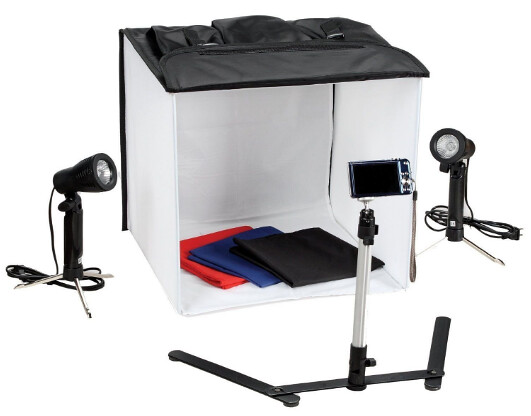 |
| My little 'mini studio', OK to begin with but now I've outgrown it. |
Though, as well as the increase in technical complexity I have also been having a lot of problems getting the right light for close-up photography.
Improving my 'mini studio'
To begin with, I bought myself a relatively cheap 'mini studio' - a small backdrop tent and a couple of continuous lamps. I hoped this would give me the consistent light I needed, and to some extent, it was adequate with the very forgiving focus and exposure of the iPhone camera.
The issue is the lamps. They are cheap little contraptions which run halogen bulbs and this set-up has two major disadvantages - the light levels are not adjustable and the bulbs get very (very) hot!
These lamps also produce a very bright and intense light which is a little too harsh and uncompromising for my little models and their delicate detail. So I had been considering upgrading the lamps to a nice set of dimmable LED panel lights (of a type I use in my video work), but this seems a little over-kill as the one good thing about my cheap halogen lamps are the are so compact and easy to store.
Well, I hit upon a compromise when I discovered that you could buy an LED bulb that fitted the bayonet mounts that my little lamps use. This would solve the heat problem - allowing me to leave the lights on longer - but they still would not be dimmable.
Left: 7W Ultra Bright GU10 LED bulbs of the type that will fit my little mini studio lamps. There are various makes and power outputs. the ones I bought were by Philips and cost £3.50 each.
What I needed was some sort of diffuser or 'soft box' for my LED lamps, to control the intensity of the light given out. I reckoned I could make a little light shade or some sort, with some semi-opaque material over the front to soften the light. (I could not even consider using any form of diffuser material with the mini lamps while they used halogens, not unless I wanted a nice little house fire!)
Making a 'soft box' for my lamps
I decided to have a go and make a simple prototype to try out the idea. The simplest material I could think of to knock up a test design for my mini 'soft box' was box cardboard, if that worked I could always look for a better material later - but, for now, I just wanted to see if the idea was feasible.
So, off we go...
Good start - it fitted snuggly enough - but now the tricky bit, the 'cone'...
Well, it looks the right shape. But how will it look when I fit it to the lamp?
Not bad! Maybe a little big, but I can always modify the size in my next version - presuming this prototype works.
Next: I'll pause here as I now need to find a suitable material to act as the diffuser. Some sort of thin white nylon or maybe even a square of baking paper, maybe? I'll see what I can find in town...
Subscribe to:
Comments (Atom)


